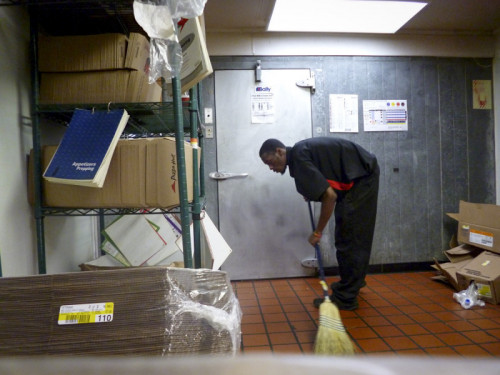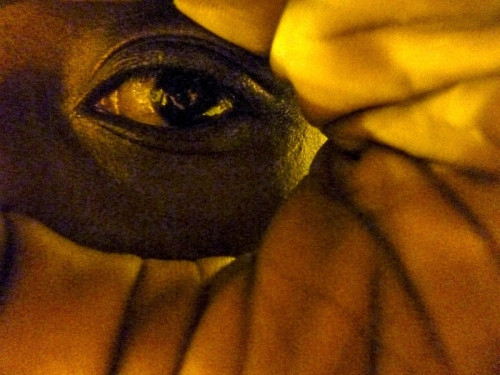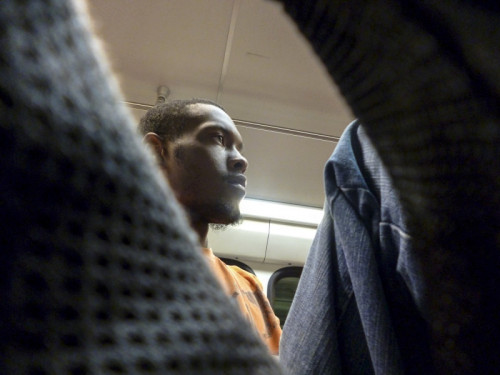In his own words, Atlanta-based D’Angelo Morrison was “homeless, hungry, young, scared, impressionable and oblivious” when he contracted HIV nearly 10 years ago. But then a friend invited him to get involved with Through Positive Eyes, a project that teaches people living with HIV the art of photography and puts a camera in their hands so they can document their lives. The experience, as Morrison tells POZ below, was transformative.
Through Positive Eyes is led by photographer Gideon Mendel and University of California, Los Angeles professor of AIDS/arts activism David Gere, PhD. Gere describes participants as “artivists”—part artist, part activist—and he says they report that photography has created a crucial outlet for their thoughts and emotions. (To learn more about the program, check out the POZ article “These Selfies Fight Stigma,” which includes a must-see and -read collection of images and related vignettes.) Workshops have been held in cities across the globe, and the resulting photography has been displayed in galleries and collected in a book, also titled Through Positive Eyes, that features a self-portrait of Morrison on the cover.

A self-portrait by D’Angelo MorrisonCourtesy of Through Positive Eyes/D’Angelo Morrison
First off, can you tell us about your HIV journey?
I was diagnosed with HIV on May 10, 2010, five days before my 20th birthday. I always tried to be safe and careful, but ultimately, I think my circumstances led me down the path toward becoming positive. I was homeless, hungry, young, scared, impressionable and oblivious—all things that can lead a young person toward making decisions that are not healthy for their well-being. I wasn’t very active sexually; however, the few times I did engage, it was usually with someone who could provide a place for me to sleep at night and food to eat. I do not know from whom I contracted HIV, but I know that it is a result of my need to survive during a difficult time in my life.
How did you get involved in the Through Positive Eyes collective?
A friend of mine informed me of Through Positive Eyes and asked me to attend the meeting with them. I was not openly disclosing my status at the time, so it took a bit of courage for me to attend, and I recall feeling overwhelmed by the occasion. Once I sat at the table and looked around me, I just felt nervous, but ultimately, I calmed after listening to others around me share their experiences. I opened up a little about my experience, and the rest is history. I completed the project and filmed a short documentary with Through Positive Eyes, and the project has stuck with me ever since.

A self-portrait by D’Angelo MorrisonCourtesy of Through Positive Eyes/D’Angelo Morrison
Did you have previous experience with photography or HIV advocacy?
I was still early into my diagnosis at the time so I had no experience in HIV advocacy. I’ve always been interested in the art. I actually grew a love for photography as a result of participating in Through Positive Eyes, and I aspire to one day start a business as a photographer. I have since become an HIV advocate, but during my time with Through Positive Eyes, I was still trying to find myself, and I had no real plans for the future. What I did know is that I did not want any other young people to feel the way I felt or experience the trauma I experienced.
I use all of the trauma and difficult situations that I have experienced as body armor in my fight to bring awareness to issues that plague my community.
How would you describe your photography?
At the time that I participated in the project, I was going through many life changes. I was partially homeless, still coping with my diagnosis and trying to find my footing both personally and professionally. I felt a little broken and alone, so I used those emotions in my photography. I took photos generally of myself alone. I wanted people to feel my pain through my artwork. Looking back at it all today, I wouldn’t change a thing because it authentically showcases where I was in that moment.

A self-portrait by D’Angelo MorrisonCourtesy of Through Positive Eyes/D’Angelo Morrison
How did the photography and storytelling project affect you?
As I mentioned earlier, I grew a deep appreciation and love for storytelling through photography. When I was in the seventh grade, I won a huge art competition by painting a Black History portrait of radio show host Tom Joyner, so I have always considered myself a bit of an artist. Through Positive Eyes helped me discover a new layer to artistic expression that I had yet to explore. When it comes to taking photos now, I take into account many different factors and options that I would have never thought of prior to participating in the project. I learned about buttons on the camera that I always ignored because I didn’t know what their purpose was. I learned about lighting, angles, focus and many other tricks that I have since adopted into my everyday photo-taking journeys.
Why do you think a project like Through Positive Eyes is important?
Through Positive Eyes for me was an opportunity to get some things off my chest that I up to that point had struggled with expressing. This project has done an amazing job of sharing stories from around the globe in a way that is authentic and tasteful. They allow their participants to use their voices in a way that doesn’t require us to utter on one word from our mouths. This project is important because it is our stories, told in our way with our artistic expression leading the way.

A self-portrait by D’Angelo MorrisonCourtesy of Through Positive Eyes/D’Angelo Morrison
Finally, what’s next for you in terms of photography and activism?
Through Positive Eyes has been showing my art work around the world at conferences and galleries. I mostly use my Instagram—@Tasiandee—as a forum for showing my work when I get into my artsy photo taking moods.
I have since gone on to have a full-time career in HIV advocacy and care. I currently work at the largest HIV/AIDS clinic in the state of Georgia, and I am a leader in a newly formed nonprofit organization in Atlanta called He Is Valuable, Inc. [Editor’s note: Read our profile titled “He Is Valuable: This Atlanta group for Black queer men gives new meaning to HIV.”]
I have and continue to serve on various committees and boards advocating for my peers on issues ranging from HIV care and prevention to homelessness and youth empowerment. What’s next for me is to take the time to strengthen my skills with photography and start my own business. I will also continue to use my platform to uplift Black queer men and fight for issues that I hold dear to my heart. I would also love to write my autobiography and help others share their stories.
I use all of the trauma and difficult situations that I have experienced as body armor in my fight to bring awareness to issues that plague my community. My struggles are far from over, but I wake up every day grateful to have another day to add to my story.

A book of self-portraits and stories by people living with HIVCourtesy of Apeture
The Through Positive Eyes exhibition remains on display at the Fowler Museum at UCLA until Sunday, February 16, before heading to the Gates Discovery Center in Seattle later this year. For information about the related book, visit Aperture.org, (the book includes a poem by Mary Bowman, who was profiled in POZ and who died May 2019 at age 30). You can learn much more about the photography program and view many more images at ThroughPositiveEyes.org.







Comments
Comments